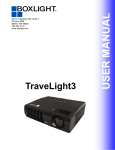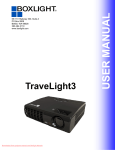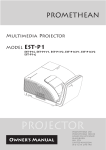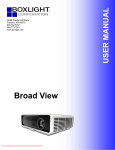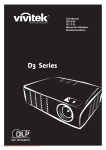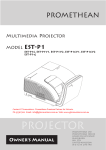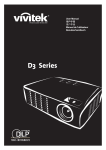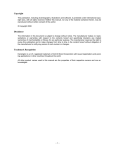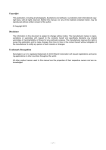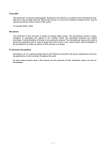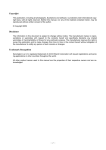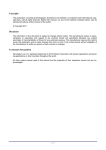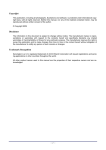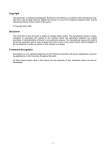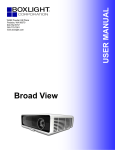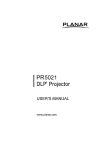Download Vivitek D326WX data projector
Transcript
Copyright This publication, including all photographs, illustrations and software, is protected under international copyright laws, with all rights reserved. Neither this manual, nor any of the material contained herein, may be reproduced without written consent of the author. © Copyright January, 2008 Disclaimer The information in this document is subject to change without notice. The manufacturer makes no representations or warranties with respect to the contents hereof and specifically disclaims any implied warranties of merchantability or fitness for any particular purpose. The manufacturer reserves the right to revise this publication and to make changes from time to time in the content hereof without obligation of the manufacturer to notify any person of such revision or changes. Trademark Recognition Kensington is a U.S. registered trademark of ACCO Brand Corporation with issued registrations and pending applications in other countries throughout the world. All other product names used in this manual are the properties of their respective owners and are acknowledged. —i— D DLLPP PPrroojjeeccttoorr— —U Usseerr’’ss M Maannuuaall Important Safety Information Important: It is strongly recommended that you read this section carefully before using the projector. These safety and usage instructions will ensure that you enjoy many years of safe use of the projector. Keep this manual for future reference. Symbols Used Warning symbols are used on the unit and in this manual to alert you of hazardous situations. The following styles are used in this manual to alert you to important information. Note: Provides additional information on the topic at hand. Important: Provides additional information that should not be overlooked. Caution: Alerts you to situations that may damage the unit. Warning: Alerts you to situations that may damage the unit, create a hazardous environment, or cause personal injury. Throughout this manual, component parts and items in the OSD menus are denoted in bold font as in this example: “Push the Menu button on the remote control to open the Main menu.” General Safety Information ¾ Do not open the unit case. Aside from the projection lamp, there are no user-serviceable parts in the unit. For servicing, contact qualified service personnel. ¾ Follow all warnings and cautions in this manual and on the unit case. ¾ The projection lamp is extremely bright by design. To avoid damage to eyes, do not look into the lens when the lamp is on. ¾ Do not place the unit on an unstable surface, cart, or stand. ¾ Avoid using the system near water, in direct sunlight, or near a heating device. ¾ Do not place heavy objects such as books or bags on the unit. — ii — PPrreeffaaccee Power Safety ¾ Only use the supplied power cord. ¾ Do not place anything on the power cord. Place the power cord where it will not be in the way of foot traffic. ¾ Remove the batteries from the remote control when storing or not in use for a prolonged period. Replacing the Lamp Replacing the lamp can be hazardous if done incorrectly. See Replacing the Projection Lamp on page 31 for clear and safe instructions for this procedure. Before replacing the lamp: ¾ Unplug the power cord. ¾ Allow the lamp to cool for about one hour. Cleaning the Projector ¾ Unplug the power cord before cleaning. See Cleaning the Projector on page 34. ¾ Allow the lamp to cool for about one hour. Regulatory Warnings Before installing and using the projector, read the regulatory notices in the Regulatory Compliance section on page 46. – iii – D DLLPP PPrroojjeeccttoorr— —U Usseerr’’ss M Maannuuaall Main Features • Lightweight unit, easy to pack away and transport. • Compatible with all major video standards including NTSC, PAL, and SECAM. • A high brightness rating allows for presentations in daylight or in lit rooms. • Supports resolutions up to UXGA at 16.7 million colors to deliver crisp, clear images. • Flexible setup allows for front, rear projections. • Line-of-vision projections remain square, with advanced keystone correction for angled projections. • Input source automatically detected. About this manual This manual is intended for end users and describes how to install and operate the DLP projector. Wherever possible, relevant information—such as an illustration and its description—has been kept on one page. This printer-friendly format is both for your convenience and to help save paper, thereby protecting the environment. It is suggested that you only print sections that are relevant to your needs. — iv — PPrreeffaaccee Table of Contents GETTING STARTED .......................................................................................................................................................... 1 PACKING CHECKLIST ........................................................................................................................................................... 1 VIEWS OF PROJECTOR PARTS ............................................................................................................................................... 2 Front-right View ............................................................................................................................................................. 2 Top view—On-screen Display (OSD) buttons and LEDs ............................................................................................... 3 Rear view ........................................................................................................................................................................ 4 Bottom view..................................................................................................................................................................... 5 REMOTE CONTROL PARTS ................................................................................................................................................... 6 REMOTE CONTROL OPERATING RANGE ............................................................................................................................... 8 PROJECTOR AND REMOTE CONTROL BUTTONS .................................................................................................................... 8 Remote Control ............................................................................................................................................................... 8 SETUP AND OPERATION................................................................................................................................................. 9 INSERTING THE REMOTE CONTROL BATTERIES ................................................................................................................... 9 CONNECTING INPUT DEVICES ............................................................................................................................................ 10 STARTING AND SHUTTING DOWN THE PROJECTOR ............................................................................................................. 11 SETTING AN ACCESS PASSWORD (SECURITY LOCK) .......................................................................................................... 13 ADJUSTING THE PROJECTOR LEVEL ................................................................................................................................... 15 ADJUSTING THE ZOOM, FOCUS AND KEYSTONE ................................................................................................................ 16 ADJUSTING THE VOLUME .................................................................................................................................................. 17 ON-SCREEN DISPLAY (OSD) MENU SETTINGS....................................................................................................... 18 OSD MENU CONTROLS ..................................................................................................................................................... 18 Navigating the OSD ...................................................................................................................................................... 18 SETTING THE OSD LANGUAGE .......................................................................................................................................... 19 OSD MENU OVERVIEW ..................................................................................................................................................... 20 OSD SUB-MENU OVERVIEW ............................................................................................................................................. 21 IMAGE MENU ..................................................................................................................................................................... 22 Color Manager.............................................................................................................................................................. 23 COMPUTER MENU.............................................................................................................................................................. 24 VIDEO/AUDIO MENU ......................................................................................................................................................... 25 INSTALLATION I MENU ...................................................................................................................................................... 26 INSTALLATION II MENU..................................................................................................................................................... 27 OSD Menu Setting......................................................................................................................................................... 28 Peripheral Test.............................................................................................................................................................. 29 Lamp Hour Reset .......................................................................................................................................................... 29 Factory Reset ................................................................................................................................................................ 30 Status............................................................................................................................................................................. 30 MAINTENANCE AND SECURITY................................................................................................................................. 31 REPLACING THE PROJECTION LAMP................................................................................................................................... 31 Resetting the Lamp........................................................................................................................................................ 33 CLEANING THE PROJECTOR................................................................................................................................................ 34 Cleaning the Lens ......................................................................................................................................................... 34 Cleaning the Case ......................................................................................................................................................... 34 USING THE KENSINGTON® LOCK ....................................................................................................................................... 35 TROUBLESHOOTING ..................................................................................................................................................... 36 COMMON PROBLEMS AND SOLUTIONS ............................................................................................................................... 36 TIPS FOR TROUBLESHOOTING ............................................................................................................................................ 36 LED ERROR MESSAGES ..................................................................................................................................................... 37 IMAGE PROBLEMS .............................................................................................................................................................. 37 LAMP PROBLEMS ............................................................................................................................................................... 38 REMOTE CONTROL PROBLEMS .......................................................................................................................................... 38 AUDIO PROBLEMS ............................................................................................................................................................. 38 HAVING THE PROJECTOR SERVICED .................................................................................................................................. 38 SPECIFICATIONS............................................................................................................................................................. 39 –v– D DLLPP PPrroojjeeccttoorr— —U Usseerr’’ss M Maannuuaall SPECIFICATIONS................................................................................................................................................................. 39 Input connectors............................................................................................................................................................ 39 PROJECTION DISTANCE V.S. PROJECTION SIZE .................................................................................................................. 40 TIMING MODE TABLE ........................................................................................................................................................ 41 PROJECTOR DIMENSIONS ................................................................................................................................................... 45 REGULATORY COMPLIANCE ..................................................................................................................................... 46 FCC WARNING .................................................................................................................................................................. 46 CANADA ............................................................................................................................................................................ 46 SAFETY CERTIFICATIONS ................................................................................................................................................... 46 EN 55022 WARNING ......................................................................................................................................................... 46 — vi — D DLLPP PPrroojjeeccttoorr –– U Usseerr’’ss M Maannuuaall GETTING STARTED Packing Checklist Carefully unpack the projector and check that the following items are included: DLP PROJECTOR RGB CABLE REMOTE CONTROL (WITH ONE 3V CR2025 BATTERY) POWER CORD RGB TO COMPONENT ADAPTER (OPTIONAL) CARRYING CASE CD-ROM (THIS USER’S MANUAL) Contact your dealer immediately if any items are missing, appear damaged, or if the unit does not work. It is recommend that you keep the original packing material should you ever need to return the equipment for warranty service. Caution: Avoid using the projector in dusty environments. –1– D DLLPP PPrroojjeeccttoorr— —U Usseerr’’ss M Maannuuaall Views of Projector Parts Front-right View ITEM LABEL DESCRIPTION 1. Ventilation opening Do not block in order to keep the projector lamp cool 2. Height-adjuster button Push to release height adjuster 3. Height adjuster Adjusts level of projector 4. Lens cap Covers lens to protect when not in use 5. IR receiver Receiver for IR signal from remote control 6. Lens Remove lens cap before use 7. Focus ring Focuses the projected image 8. Zoom ring Enlarges the projected image 9. Function keys See Top view—On-screen Display (OSD) buttons and LEDs. SEE PAGE: 15 6 16 3 Important: Ventilation openings on the projector allow for good air circulation, which keeps the projector lamp cool. Do not obstruct any of the ventilation openings. –2– D DLLPP PPrroojjeeccttoorr –– U Usseerr’’ss M Maannuuaall Top view—On-screen Display (OSD) buttons and LEDs ITEM LABEL 1. (Power) 2. ▲ (Up cursor) 3. 4. Power LED Over Temp LED SEE DESCRIPTION PAGE: Turns the projector On or Off Navigates and changes settings in the OSD 18 Green Power On Off Power Off (AC Off) Flashing Error code On System over temperature Off Normal State Orange Lamp is ready to be powered-on. Flashing Lamp not ready (Warm-up/shutting down/cooling) (see LED Error Messages on page 37) 5. Ready LED 6. Menu Open and exits the OSD buttons 7. ◄ (Left cursor)/ Source Detects the input device Navigates and changes settings in the OSD 8. ▼ (Down cursor) / Quick Menu Quick Menu – For Keystone, Audio Volume Navigates and changes settings in the OSD 9. ► (Right cursor)/ Auto Optimizes image size, position, and resolution Navigates and changes settings in the OSD –3– 18 16, 17, 18 18 D DLLPP PPrroojjeeccttoorr— —U Usseerr’’ss M Maannuuaall Rear view ITEM LABEL DESCRIPTION 1. AC IN Connect the POWER CABLE 2. USB Connect the USB CABLE from a computer 3. AUDIO Connect the AUDIO CABLE from the input device 4. S-VIDEO Connect the S-VIDEO CABLE from a video device 5. VIDEO Connect the VIDEO CABLE from a video device 6. VGA Connect the RGB cable (supplied) from a computer DIGITAL VIDEO (For D326WX only) Connect the HDMI digital video CABLE from a video device (Security Lock) Secure to permanent object with a Kensington® Lock 7. 8. SEE PAGE: 11 10 35 Note: If your video equipment has both S-VIDEO and RCA jacks (composite video) connect to the S-VIDEO connector. S-VIDEO provides a better quality signal. –4– D DLLPP PPrroojjeeccttoorr –– U Usseerr’’ss M Maannuuaall Bottom view ITEM LABEL DESCRIPTION 1. Lamp cover Remove when changing the lamp. 2. Lens cap hook Place strap through to fasten the lens cap cover. 3. Tilt adjustor Rotate adjuster lever to adjust angle position. 4. Height adjustor button Push to release adjustor. 5. Height adjustor Adjuster drops down when adjuster button is pushed. –5– SEE PAGE: 31 15 D DLLPP PPrroojjeeccttoorr— —U Usseerr’’ss M Maannuuaall Remote Control Parts Important: 1. Avoid using the projector with bright fluorescent lighting turned on. Certain high-frequency fluorescent lights can disrupt remote control operation. 2. Be sure nothing obstructs the path between the remote control and the projector. If the path between the remote control and the projector is obstructed, you can bounce the signal off certain reflective surfaces such as projector screens. 3. The buttons and keys on the projector have the same functions as the corresponding buttons on the remote control. This user’s manual describes the functions based on the remote control. –6– D DLLPP PPrroojjeeccttoorr –– U Usseerr’’ss M Maannuuaall ITEM LABEL DESCRIPTION SEE PAGE: 1. Up cursor Navigates and changes settings in the OSD 2. Enter Changes settings in the OSD 3. Power Turns the projector On or Off 11 4. Right cursor Navigates and changes settings in the OSD 18 5. Volume + Increase volume 6. Volume - Decrease volume 7. Mute Mutes the built-in speaker 8. Freeze Freeze/unfreezes the on-screen picture 9. Source Detects the input device 10. Auto Auto adjustment for frequency, tracking, size, position (RGB only) 11. Keystone top Corrects image-trapezoid (wider top) effect 12. Keystone bottom Corrects image trapezoid (wider bottom) effect 13. Down cursor Navigates and changes settings in the OSD 14. Left cursor Navigates and changes settings in the OSD 15. Menu Opens the OSD 18 17 16 –7– 18 D DLLPP PPrroojjeeccttoorr— —U Usseerr’’ss M Maannuuaall Remote Control Operating Range The remote control uses infrared transmission to control the projector. It is not necessary to point the remote directly at the projector. Provided you are not holding the remote perpendicular to the sides or the rear of the projector, the remote will function well within a radius of about 7 meters (23 feet) and 15 degrees above or below the projector level. If the projector does not respond to the remote control, move a little closer. Projector and Remote Control Buttons The projector can be operated using the remote control or the buttons on the top of the projector. All operations can be carried out with the remote control; however, the buttons on the projector are limited in use. The following illustration shows the corresponding buttons on the remote control and on the projector. Remote Control Some buttons on the projector have multiple functions. For example, item 3/6/7 on the projector functions as the keystone button, volume adjuster, and as the down cursor key. –8– SETUP AND OPERATION Inserting the Remote Control Batteries 1. 2. 3. Remove the battery compartment cover by sliding the cover in the direction of the arrow. (A) Pull out the cover. (B) Insert the battery with the positive side facing up. Replace the cover. Caution: 1. Only use a 3V lithium battery (CR2025). 2. Dispose of used batteries according to local ordinance regulations. 3. Remove the battery when not using the projector for prolonged periods. –9– D DLLPP PPrroojjeeccttoorr— —U Usseerr’’ss M Maannuuaall Connecting Input Devices A PC or notebook computer and video devices can be connected to the projector at the same time. Video devices include DVD, VCD, and VHS players, as well as movie camcorders and digital still cameras. Check the user manual of the connecting device to confirm it has the appropriate output connector. ITEM LABEL DESCRIPTION A USB B AUDIO C S-VIDEO Connect the S-VIDEO CABLE from a video device. D VIDEO Connect the VIDEO CABLE from a video device. E Connect the USB CABLE from a computer. Connect the AUDIO CABLE from the computer’s audio-out connector. Connect the AUDIO CABLE (mini jack-to-RCA x 2) from a video device. Connect the RGB CABLE from a computer. VGA Digital Video (HDMI) (For D326WX only) Connect DVD input YCbCr / YPbPr, through optional RGB to COMPONENT ADAPTOR. Connect the Digital Video from any video device Warning: As a safety precaution, disconnect all power to the projector and connecting devices before making connections. – 10 – D DLLPP PPrroojjeeccttoorr –– U Usseerr’’ss M Maannuuaall Starting and Shutting down the Projector 1. 2. 3. Connect the power cord to the projector. Connect the other end to a wall outlet. The Power and Ready LEDs on the projector light. Turn on the connected devices. Ensure the Ready LED displays a solid orange and not a flashing orange. Then press the Power button to turn on the projector. The projector splash screen displays and connected devices are detected. See Setting an Access Password (Security Lock) on page 13 if security lock is enabled. 4. If more than one input device is connected, press the Source button and use ▲▼ to scroll among devices. (Component is supported through the RGB to COMPONENT ADAPTER.) • RGB: Analog RGB Component: DVD input YCbCr / YPbPr, or HDTV input YPbPr via HD15 connector • Composite Video: Traditional composite video • S-Video: Super video (Y/C separated) • Digital Video (HDMI): Digital Video source – 11 – D DLLPP PPrroojjeeccttoorr— —U Usseerr’’ss M Maannuuaall 5. When the “Power Off? /Press Power again” message appears, press the Power button. The projector turns off. Caution: 1. Be sure to remove the lens cap before starting projector. 2. Do not unplug the power cord until the Ready LED stops flashing–indicating the projector has cooled down. – 12 – D DLLPP PPrroojjeeccttoorr –– U Usseerr’’ss M Maannuuaall Setting an Access Password (Security Lock) You can use the four (arrow) buttons to set a password and prevent unauthorized use of the projector. When enabled, the password must be entered after you power on the projector. (See Navigating the OSD on page 18 and Setting the OSD Language on page 19 for help on using OSD menus.) Important: Keep the password in a safe place. Without the password, you will not be able to use the projector. If you lose the password, contact your reseller for information on clearing the password. 1. 2. 3. 4. Press the Menu button to open the OSD menu. Press the cursor ◄► button to move to the Installation I menu. Press the cursor ▲▼ button to select Security Lock. Press the cursor ◄► button to enable or disable security lock function. A password dialog box automatically appears. – 13 – D DLLPP PPrroojjeeccttoorr— —U Usseerr’’ss M Maannuuaall 5. You can use the cursor buttons ▲▼◄► either on keypad or IR remote control for password entry. You can use any combination including the same arrow five times, but not less than five. Press the cursor buttons in any order to set the password. Push the Menu button to exit the dialog box. 6. The password confirm menu appears when user presses the power-on key in case the Security Lock is enabled. Enter the password in the order you set it at step 5. In case you forget the password, please contact the service center. Service center will validate the owner and help reset the password. – 14 – D DLLPP PPrroojjeeccttoorr –– U Usseerr’’ss M Maannuuaall Adjusting the Projector Level Take note of the following when setting up the projector: • The projector table or stand should be level and sturdy. • Position the projector so that it is perpendicular to the screen. • Ensure the cables are in a safe location. You could trip over them. 1. To raise the level of the projector, lift the projector [A] and press the height-adjuster button [B]. The height adjuster drops down [C]. 2. 3. To lower the level of the projector, press the height-adjuster button and push down on the top of the projector. To adjust the angle of the picture, turn the tilt-adjuster [D] right or left until the desired angle has been achieved. – 15 – D DLLPP PPrroojjeeccttoorr— —U Usseerr’’ss M Maannuuaall Adjusting the Zoom, Focus and Keystone 1. 2. 3. Use the Image-zoom control (on the projector only) to resize the projected image and screen size B . Use the Image-focus control (on the projector only) to sharpen the projected image A . Use the Quick Menu button on the projector or Keystone on the remote control to correct imagetrapezoid (wider top or bottom) effect. Remote control and OSD panel 4. The keystone control appears on the display. – 16 – D DLLPP PPrroojjeeccttoorr –– U Usseerr’’ss M Maannuuaall Adjusting the Volume 1. 2. 3. Press the Volume +/buttons on the remote control. The volume control appears on the display. Press the Down Cursor button on the keypad to adjust Volume +/-. Press the Mute button to turn off the volume (This feature is available only on the remote). – 17 – ON-SCREEN DISPLAY (OSD) MENU SETTINGS OSD Menu Controls The projector has an OSD that lets you make image adjustments and change various settings. Navigating the OSD You can use the remote control cursor buttons or the buttons on the top of the projector to navigate and make changes to the OSD. The following illustration shows the corresponding buttons on the remote control and on the projector. 1. To enter the OSD, press the Menu button. 2. There are five menus. Press the cursor ◄► button to move through the menus. 3. Press the cursor ▲▼ button to move up and down in a menu. 4. Press ◄► to change values for settings. 5. Press Menu to close the OSD or leave a submenu. Note: Depending on the video source, not all items in the OSD are available. For example, the Horizontal/Vertical Position items in the Computer menu can only be modified when connected to a PC. Items that are not available cannot be accessed and are grayed out. – 18 – D DLLPP PPrroojjeeccttoorr –– U Usseerr’’ss M Maannuuaall Setting the OSD Language Set the OSD language to your preference before continuing. 1. Press the Menu button. Press the cursor ◄► button to navigate to Installation I. 2. Press the cursor ▲▼ button until Language is highlighted. 3. Press the cursor ◄► button until the language you want is highlighted. 4. Press the Menu button twice to close the OSD. – 19 – D DLLPP PPrroojjeeccttoorr— —U Usseerr’’ss M Maannuuaall OSD Menu Overview Use the following illustration to quickly find a setting or determine the range for a setting. – 20 – D DLLPP PPrroojjeeccttoorr –– U Usseerr’’ss M Maannuuaall OSD Sub-Menu Overview – 21 – D DLLPP PPrroojjeeccttoorr— —U Usseerr’’ss M Maannuuaall Image Menu Press the Menu button to open the OSD menu. Press the cursor ◄► button to move to the Image Menu. Press the cursor ▲▼ button to move up and down in the Image menu. Press ◄► to change values for settings. ITEM DESCRIPTION Display Mode Press the cursor ◄► button to set the display mode. Brilliant Color Press the cursor ◄► button to adjust the Brilliant Color value. Brightness Press the cursor ◄► button to adjust the display brightness. Contrast Press the cursor ◄► button to adjust the display contrast. Sharpness Press the cursor ◄► button to adjust the display sharpness level. Gamma Press the cursor ◄► button to adjust the gamma correction of the display. Color Space Press the cursor ◄► button to adjust the color space. Color Temperature Press the cursor ◄► button to select different color temperature. Color Manager Press Enter / ► to enter the color manager menu. See Color Manager on page 23 for more information. Reset Press Enter / ► to reset all settings to default values. – 22 – D DLLPP PPrroojjeeccttoorr –– U Usseerr’’ss M Maannuuaall Color Manager Press (Enter) / ► to enter the color manger sub menu. ITEM DESCRIPTION Red Select to enter the Red Color Manager. Press the ◄► buttons to adjust the Hue, Saturation, and Gain. Green Select to enter the Green Color Manager. Press the ◄► buttons to adjust the Hue, Saturation, and Gain. Blue Select to enter the Blue Color Manager. Press the ◄► buttons to adjust the Hue, Saturation, and Gain. Cyan Select to enter the Cyan Color Manager. Press the ◄► buttons to adjust the Hue, Saturation, and Gain. Magenta Select to enter the Magenta Color Manager. Press the ◄► buttons to adjust the Hue, Saturation, and Gain. Yellow Select to enter the Yellow Color Manager. Press the◄► buttons to adjust the Hue, Saturation, and Gain. White Select to enter the White Color Manager. Press the ◄► buttons to adjust the Hue, Saturation, and Gain. – 23 – D DLLPP PPrroojjeeccttoorr— —U Usseerr’’ss M Maannuuaall Computer Menu Press the Menu button to open the OSD menu. Press the cursor ◄► button to move to the Computer menu. Press the cursor ▲▼ button to move up and down in the computer menu. Press ◄► to change values for settings. ITEM DESCRIPTION Horizontal Position Press the cursor ◄► button to adjust the display position to left or right. Vertical Position Press the cursor ◄► button to adjust the display position to up or down. Frequency Press the cursor ◄► button to adjust the A/D sampling clock. Tracking Press the cursor ◄► button to adjust the A/D sampling dot. Auto Image Press (Enter) / ► to automatically adjustment for phase, tracking, size and position. – 24 – D DLLPP PPrroojjeeccttoorr –– U Usseerr’’ss M Maannuuaall Video/Audio Menu Press the Menu button to open the OSD menu. Press the cursor ◄► button to move to the Video/Audio menu. Press the cursor ▲▼ button to move up and down in the Video/Audio menu. Press ◄► to change values for settings. ITEM DESCRIPTION Video AGC Press the ◄► buttons to enable or disable the Automatic Gain Control for video source. Video Saturation Press the ◄► buttons to adjust the video saturation. Video Tint Press the ◄► buttons to adjust the video tint/hue. Film Mode Press the ◄► buttons to select a different film mode. Video Overscan Press the ◄► buttons to enable or disable video over scan. Volume Press the ◄► buttons to adjust the audio volume level. Mute Press the ◄► buttons to turn On or Off the speaker. Reset Press Enter / ► to reset all settings to default values. Note: Video jagging may occur when playing interlace video. To overcome this issue, open the Video / Audio menu and adjust the Film Mode feature. – 25 – D DLLPP PPrroojjeeccttoorr— —U Usseerr’’ss M Maannuuaall Installation I Menu Press the Menu button to open the OSD menu. Press the cursor ◄► button to move to the Installation I menu. Press the cursor ▲▼ button to move up and down in the Installation I menu. Press ◄► to change values for settings. ITEM DESCRIPTION Language Press the cursor ◄► button to select a different localization menu. Auto Source Press the cursor ◄► button to enable or disable the automatically searching of all input port to find out the valid source. Blank Screen Press the cursor ◄► button to select different color to blank the screen. Projection Press the cursor ◄► button to choose from two projection methods: Security Lock Press the cursor ◄► button to enable or disable security lock function. Aspect Ratio Keystone Press the cursor ◄► button to adjust the video aspect ratio. Note: The Aspect Ratio function is only accessible when the Digital Zoom is not active. Press the cursor ◄► button to adjust the display keystone. Press Enter / ► to enter the Digital Zoom menu. Press ▲ to zoom in; press ▼ to zoom out. Digital Zoom Use the buttons to employ the Pan function. Note: You must zoom in before the Pan menu is accessible. Note: Digital zoom is disabled in SXGA/SXGA+/UXGA resolutions. – 26 – D DLLPP PPrroojjeeccttoorr –– U Usseerr’’ss M Maannuuaall Installation II Menu Press the Menu button to open the OSD menu. Press the cursor ◄► button to move to the Installation II menu. Press the cursor ▲▼ button to move up and down in the Installation II menu. ITEM DESCRIPTION Auto Power Off (min.) Press the cursor ◄► button to enable or disable automatic shutdown of lamp when no signal. Auto Power On Press the cursor ◄► button to enable or disable automatic power On when AC power is supplied. Fan Speed Press the cursor ◄► button to toggle between Normal and High fan speeds. Note: We recommend selecting high speed in high temperatures, high humidity, or high altitude areas. Lamp Mode Press the cursor ◄► button to select the lamp mode for higher brightness or lower brightness to save lamp life. OSD Menu Setting (Enter) / ► to enter the OSD setting menu. See page 18 for more information on Press OSD setting menu. Peripheral Test Press (Enter) / ► to enter the Peripheral Test menu. See page 29 for more information on Peripheral Test. Lamp Hour Reset Press (Enter) / ► to confirm lamp hour reset. Press Menu to cancel. See page 29 for more information on Lamp Hour Reset. Factory Reset Press (Enter) / ► to reset the entire item to default value. See page 30 for more information on Factory Reset. Status Press (Enter) / ► to enter the Status menu. See page 30 for more information on Status. – 27 – D DLLPP PPrroojjeeccttoorr— —U Usseerr’’ss M Maannuuaall OSD Menu Setting ITEM DESCRIPTION Menu Position Press ◄► button to select different OSD location. Translucent Menu Press ◄► button to select OSD background translucent level. Menu Display Press ◄► button to select OSD timeout delay. – 28 – D DLLPP PPrroojjeeccttoorr –– U Usseerr’’ss M Maannuuaall Peripheral Test ITEM DESCRIPTION Remote Control Test Press (Enter) / ► to test the IR remote controller for diagnostic. Button Test Press (Enter) / ► to test the button on keypad. Color Test Press (Enter) / ► to select different colors on screen. Sound Test Press (Enter) / ► to test the sound function of the internal speaker. Lamp Hour Reset Please refer to Resetting the Lamp on page 33 to reset the lamp hour counter. – 29 – D DLLPP PPrroojjeeccttoorr— —U Usseerr’’ss M Maannuuaall Factory Reset Press the cursor ▲▼ button to move up and down in the Installation II menu. Select the Factory (Enter) / ► to reset all the menu items to the factory default values. Reset sub menu and press Status Press the cursor ▲▼ button to move up and down in the Installation II menu. Select the (Enter) / ► to enter the Status sub menu. Installation II sub menu and press ITEM DESCRIPTION Active Source Display the activated source. Video Information Displays resolution/video information for RGB source and color standard for Video source. Lamp Hours Lamp hour used information is displayed. ECO and Normal counter are separated. – 30 – D DLLPP PPrroojjeeccttoorr –– U Usseerr’’ss M Maannuuaall MAINTENANCE AND SECURITY Replacing the Projection Lamp The projection lamp should be replaced when it burns out. It should only be replaced with a certified replacement part, which you can order from your local dealer. Important: a. The projection lamp used in this product contains a small amount of mercury b. Do not dispose this product with general household waste. c. Disposal of this product must be carried out in accordance with the regulations of your local authority. Warning: Be sure to turn off and unplug the projector at least 30 minutes before replacing the lamp. Failure to do so could result in a severe burn. 1. 2. Loosen the two captive screws on the lamp compartment cover (A). Remove the lamp compartment cover (B). – 31 – D DLLPP PPrroojjeeccttoorr— —U Usseerr’’ss M Maannuuaall 3. 4. 5. Remove the two screws from the lamp module (A). Lift the module handle up (B). Pull firmly on the module handle to remove the lamp module. – 32 – D DLLPP PPrroojjeeccttoorr –– U Usseerr’’ss M Maannuuaall 6. Reverse steps 1 to 5 to install the new lamp module. While installing, align the lamp module with the connector and ensure it is level to avoid damage. Note: The lamp module must sit securely in place and the lamp connector must be connected properly before tightening the screws. Resetting the Lamp After replacing the lamp, you should reset the lamp hour counter to zero. Refer to the following: 1. 2. 3. 4. Press the Menu button to open the OSD menu. Press the cursor ◄► button to move to the Installation II menu. Press the cursor ▲▼ button to move down to Lamp Hour Reset. Press the cursor ► or button. A message screen appears. 5. 6. Press ▼ ▲ ◄ ► buttons to reset the lamp hour. Press the Menu button to get back to Installation II. – 33 – D DLLPP PPrroojjeeccttoorr— —U Usseerr’’ss M Maannuuaall Cleaning the Projector Cleaning the projector to remove dust and grime will help ensure trouble-free operation. Warning: 1. Be sure to turn off and unplug the projector at least 30 minutes before cleaning. Failure to do so could result in a severe burn. 2. Use only a dampened cloth when cleaning. Do not allow water to enter the ventilation openings on the projector. 3. If a little water gets into the projector interior while cleaning, leave unplugged in a well-ventilated room for several hours before using. 4. If a lot of water gets into the projector interior when cleaning, have the projector serviced. Cleaning the Lens You can purchase optic lens cleaner from most camera stores. Refer to the following to clean the projector lens. 1. Apply a little optic lens cleaner to a clean soft cloth. (Do not apply the cleaner directly to the lens.) 2. Lightly wipe the lens in a circular motion. Caution: 1. Do not use abrasive cleaners or solvents. 2. To prevent discoloration or fading, avoid getting cleaner on the projector case. Cleaning the Case Refer to the following to clean the projector case. 1. Wipe off dust with a clean dampened cloth. 2. Moisten the cloth with warm water and mild detergent (such as used to wash dishes), and then wipe the case. 3. Rinse all detergent from the cloth and wipe the projector again. Caution: To prevent discoloration or fading of the case, do not use abrasive alcohol-based cleaners. – 34 – D DLLPP PPrroojjeeccttoorr –– U Usseerr’’ss M Maannuuaall Using the Kensington® Lock If you are concerned about security, attach the projector to a permanent object with the Kensington slot and a security cable. Note: Contact your vendor for details on purchasing a suitable Kensington security cable. The security lock corresponds to Kensington’s MicroSaver Security System. If you have any comment, contact: Kensington, 2853 Campus Drive, San Mateo, CA 94403, U.S.A. Tel: 800-535-4242, http://www.Kensington.com. – 35 – TROUBLESHOOTING Common problems and solutions These guidelines provide tips to deal with problems you may encounter while using the projector. If the problem remains unsolved, contact your dealer for assistance. Often after time spent troubleshooting, the problem is traced to something as simple as a loose connection. Check the following before proceeding to the problem-specific solutions. • Use some other electrical device to confirm that the electrical outlet is working. • Ensure the projector is turned on. • Ensure all connections are securely attached. • Ensure the attached device is turned on. • Ensure a connected PC is not in suspending mode. • Ensure a connected notebook computer is configured for an external display. (This is usually done by pressing an Fn-key combination on the notebook.) Tips for Troubleshooting In each problem-specific section, try the steps in the order suggested. This may help you to solve the problem more quickly. Try to pin point the problem and thus avoid replacing non-defective parts. For example, if you replace batteries and the problem remains, put the original batteries back and go to the next step. Keep a record of the steps you take when troubleshooting: The information may be useful when calling for technical support or for passing on to service personnel. – 36 – D DLLPP PPrroojjeeccttoorr –– U Usseerr’’ss M Maannuuaall LED Error Messages ERROR CODE MESSAGES Power LED Blink Over Temp LED Ready LED Blink Over temperature 0 ON 0 Thermal break status error 4 0 0 Lamp error 5 0 0 Fan1 error 6 0 1 Fan2 error 6 0 2 Fan3 error 6 0 3 Lamp door open 7 0 0 DMD error 8 0 0 Color wheel error 9 0 0 In the event of an error, please disconnect the AC power cord and wait for one (1) minute before restarting the projector. If the Power or Ready LEDs are still blinking or the Over Temp LED is lit, contact your service center. Image Problems Problem: No image appears on the screen 1. Verify the settings on your notebook or desktop PC. 2. Turn off all equipment and power up again in the correct order. Problem: The image is blurred 1. Adjust the Focus on the projector. 2. Press the Auto button on the remote control or projector. 3. Ensure the projector-to-screen distance is within the 10-meter (33-feet) specified range. 4. Check that the projector lens is clean. Problem: The image is wider at the top or bottom (trapezoid effect) 1. Position the projector so it is as perpendicular to the screen as possible. 2. Use the Keystone button on the remote control or Quick Menu on the projector to correct the problem. Problem: The image is reversed Check the Projection setting on the Installation I menu of the OSD. Problem: The image is streaked 1. Set the Frequency and Tracking settings on the Computer menu of the OSD to the default settings. 2. To ensure the problem is not caused by a connected PC’s video card, connect to another computer. Problem: The image is flat with no contrast Adjust the Contrast setting on the Image menu of the OSD. Problem: The color of the projected image does not match the source image. Adjust the Color Temperature and Gamma settings on the Image menu of the OSD. – 37 – D DLLPP PPrroojjeeccttoorr— —U Usseerr’’ss M Maannuuaall Lamp Problems Problem: There is no light from the projector 1. Check that the power cable is securely connected. 2. Ensure the power source is good by testing with another electrical device. 3. Restart the projector in the correct order and check that the Power LED is green. 4. If you have replaced the lamp recently, try resetting the lamp connections. 5. Replace the lamp module. 6. Put the old lamp back in the projector and have the projector serviced. Problem: The lamp goes off 1. Power surges can cause the lamp to turn off. Re-plug power cord. When the Ready LED is on, press the power button. 2. Replace the lamp module. 3. Put the old lamp back in the projector and have the projector serviced. Remote Control Problems Problem: The projector does not respond to the remote control 1. Direct the remote control towards remote sensor on the projector. 2. Ensure the path between remote and sensor is not obstructed. 3. Turn off any fluorescent lights in the room. 4. Check the battery polarity. 5. Replace the batteries. 6. Turn off other Infrared-enabled devices in the vicinity. 7. Have the remote control serviced. Audio Problems Problem: There is no sound 1. Adjust the volume on the remote control. 2. Adjust the volume of the audio source. 3. Check the audio cable connection. 4. Test the source audio output with other speakers. 5. Have the projector serviced. Problem: The sound is distorted 1. Check the audio cable connection. 2. Test the source audio output with other speakers. 3. Have the projector serviced. Having the Projector Serviced If you are unable to solve the problem, you should have the projector serviced. Pack the projector in the original carton. Include a description of the problem and a checklist of the steps you took when trying to fix the problem: The information may be useful to service personnel. For servicing, return the projector to the place you purchased it. – 38 – SPECIFICATIONS Specifications D326MX D326WX TI DMD Type X, 0.55 inches, XGA TI DMD Type X, 0.65 inches, WXGA XGA 1024x768 Native WXGA 1280x768 Native Model Display type Resolution 1.5 meters ~ 10 meters Projection distance 34 to 260 inches Projection screen size 39 to 300 inches Manual focus / Manual zoom Projection lens 1.15:1 Zoom ratio Vertical keystone correction +/- 15 degrees Projection methods Desktop front/rear Data compatibility IBM PC or compatibles (VGA, SVGA, XGA, SXGA, UXGA), Mac 480i, 576i, 480p, 576p, 720p, 1080i SDTV/EDTV/ HDTV NTSC/NTSC 4.43, PAL (B/G/H/I/M/N 60), SECAM Video compatibility 15, 31 - 70 KHz H-Sync 15, 31 - 90 KHz 50 - 85 Hz V-Sync FCC-B, UL, cUL, CB, CE, CCC Safety certification 5° ~ 35°C Operation temperature 220 mm (W) x 71 mm (H) x 178 mm (D) Dimensions AC Input AC Universal 100 ~ 240, Typical @ 110 VAC (100~240)/±10% Typical 260W (standard mode); Typical 210W (ECO mode) Power consumption < 5 watts Stand By Normal Mode: 200W; Eco Mode: 160W Lamp 1W / 4 ohm mono speaker Audio speaker RGB PC Video Composite video (RCA X 1) S-Video (Mini-DIN) Mini-jack Audio Kensington lock Security Input connectors PC Video Composite video (RCA X 1); HDMI VGA USB (Service only) Composite video (RCAx1) S-Video (Mini-DIN); HDMI Audio Mini-jack Security Kensington slot – 39 – D DLLPP PPrroojjeeccttoorr— —U Usseerr’’ss M Maannuuaall Projection Distance V.S. Projection Size Screen width A B Image Hight Keystone Correction Angel A Projection Distance Maximum Screen Size (W) diagonal Projection Distance L XGA WXGA 1.16m 0.76m 0.89m 3.8’ 30” 2.32m 1.52m 7.6' Maximum Screen Size (Tele) Width A Projection Height C diagonal Width B Height D XGA WXGA Distance XGA WXGA 0.46m 0.61m 0.76m 1.34m 0.76m 0.89m 35” 18” 24” 30” 4.4’ 30” 1.78m 0.91m 1.22m 1.52m 60" 70" 36" 48" 60" 3.47m 2.29m 2.67m 1.37m 1.83m 11.4' 90" 105" 54" 4.63m 3.05m 3.55m 15.2' 120" 5.79m XGA WXGA 0.46m 0.61m 0.76m 35” 18” 24” 30” 1.52m 1.78m 0.91m 1.22m 1.52m 8.8' 60" 70" 36" 48" 60" 2.29m 4.02m 2.29m 2.67m 1.37m 1.83m 2.29m 72" 90" 13.2' 90" 105" 54" 72" 90" 1.83m 2.44m 3.05m 5.36m 3.05m 3.55m 1.83m 2.44m 3.05m 140" 72" 96" 120" 17.6' 120" 140" 72" 96" 120" 3.81m 4.44m 2.29m 3.05m 3.81m 6.71m 3.81m 4.44m 2.29m 3.05m 3.81m 19' 150" 175" 90" 120" 150" 22' 150" 175" 90" 120" 150" 7.72m 5.08m 5.92m 3.05m 4.06m 5.08m 8.94m 5.08m 5.92m 3.05m 4.06m 5.08m 25.3' 200" 233" 120" 160" 200" 29.3' 200" 233" 120" 160" 200" 9.65m 6.35m 7.41m 3.81m 5.08m 6.35m 11.18m 6.35m 7.41m 3.81m 5.08m 6.35m 31.7' 250" 292" 150" 200" 250" 36.7' 250" 292" 150" 200" 250" 11.58m 7.62m 4.57m 6.1m 38' 300" 180" 240" 2.68m – 40 – D DLLPP PPrroojjeeccttoorr –– U Usseerr’’ss M Maannuuaall Timing Mode Table The projector can display several resolutions. The following table outlines the resolutions that can be displayed by the projector. Signal Resolution Frequency Refresh (KHZ) Rate(HZ) XGA Video Digital WXGA Analog Video Digital Analog NTSC -- 15.734 60.0 Ο -- -- Ο -- -- PAL / SECAM -- 15.625 50.0 Ο -- -- Ο -- -- 640 x 350 31.5 70.1 -- -- Ο -- Ο Ο 640 x 350 37.9 85.1 -- -- Ο -- Ο Ο 720 x 350 31.5 70 -- -- Ο -- Ο Ο 640 x 400 31.5 70.1 -- -- Ο -- Ο Ο 640 x 400 37.9 85.1 -- -- Ο -- Ο Ο 720 x 400 31.5 70 -- -- Ο -- Ο Ο 720 x 400 37.9 85 -- -- Ο -- Ο Ο 640 x 480 31.5 60 -- -- Ο -- Ο Ο 640 x 480 37.9 72.8 -- -- Ο -- Ο Ο 640 x 480 37.5 75 -- -- Ο -- Ο Ο 640 x 480 43.3 85 -- -- Ο -- Ο Ο 800 x 600 35.2 56.3 -- -- Ο -- Ο Ο 800 x 600 37.9 60.3 -- -- Ο -- Ο Ο 800 x 600 46.9 75 -- -- Ο -- Ο Ο 800 x 600 48.1 72.2 -- -- Ο -- Ο Ο 800 x 600 53.7 85.1 -- -- Ο -- Ο Ο 1024 x 768 48.4 60 -- -- Ο -- Ο Ο 1024 x 768 56.5 70.1 -- -- Ο -- Ο Ο 1024 x 768 57.7 72 -- -- Ο -- Ο Ο 1024 x 768 60.0 75 -- -- Ο -- Ο Ο 1024 x 768 68.7 85 -- -- Ο -- Ο Ο 1280 x 1024 64.0 60 -- -- Ο -- Ο Ο 1280 x 1024 80.0 75 -- -- Ο -- Ο Ο 1280 x 1024 91.1 85 -- -- Ο -- Ο Ο 1280 x 768 47.4 60 -- -- Ο -- Ο Ο 1600 x1200 75.0 60 -- -- Ο -- Ο Ο VESA – 41 – D DLLPP PPrroojjeeccttoorr— —U Usseerr’’ss M Maannuuaall Signal Macbook 相容性 Mac book Pro (Intel) 相容性 Resolution Frequency (KHZ) Refresh Rate (HZ) XGA Video WXGA Digital Analog Video Digital Analog 800x600 -- 60 -- -- Ο -- Ο Ο 800x600 -- 72 -- -- Ο -- Ο Ο 800x600 -- 75 -- -- Ο -- Ο Ο 800x600 -- 85 -- -- Ο -- Ο Ο 1024x768 -- 60 -- -- Ο -- Ο Ο 1024x768 -- 70 -- -- Ο -- Ο Ο 1024x768 -- 75 -- -- Ο -- Ο Ο 1024x768 -- 85 -- -- Ο -- Ο Ο 1280x720 -- 60 -- -- -- -- Ο Ο 1280x720 -- 75 -- -- -- -- -- Ο 1280x720 -- 85 -- -- -- -- -- Ο 1280x768 -- 60 -- -- Ο -- Ο Ο 1280x768 -- 75 -- -- Ο -- -- -- 1280x768 -- 85 -- -- Ο -- -- -- 1280x800 -- 60 -- -- Ο -- -- Ο 1280x1024 -- 60 -- -- -- -- Ο -- 1280x1024 -- 75 -- -- -- -- Ο -- 800x600 -- 60 -- -- Ο -- Ο Ο 800x600 -- 72 -- -- Ο -- Ο Ο 800x600 -- 75 -- -- Ο -- Ο Ο 800x600 -- 85 -- -- Ο -- -- Ο 1024x768 -- 60 -- -- Ο -- Ο Ο 1024x768 -- 70 -- -- Ο -- Ο Ο 1024x768 -- 75 -- -- Ο -- Ο Ο 1024x768 -- 85 -- -- Ο -- Ο Ο 1280x720 -- 60 -- -- Ο -- -- Ο 1280x720 -- 75 -- -- -- -- -- Ο 1280x720 -- 85 -- -- -- -- -- Ο 1280x768 -- 60 -- -- Ο -- Ο Ο 1280x768 -- 75 -- -- Ο -- -- -- 1280x768 -- 85 -- -- Ο -- -- -- 1280x800 -- 60 -- -- Ο -- -- Ο 1280x1024 -- 60 -- -- Ο -- -- Ο 1280x1024 -- 75 -- -- Ο -- -- Ο – 42 – D DLLPP PPrroojjeeccttoorr –– U Usseerr’’ss M Maannuuaall Signal Power Mac G5 相容性 Power Mac G4 相容性 Resolution Frequency (KHZ) Refresh Rate (HZ) XGA Video WXGA Digital Analog Video Digital Analog 800x600 -- 56 -- -- -- -- -- -- 800x600 -- 60 -- -- Ο -- -- Ο 800x600 -- 72 -- -- Ο -- -- Ο 800x600 -- 75 -- -- Ο -- -- Ο 800x600 -- 85 -- -- Ο -- -- Ο 1024x768 -- 60 -- -- Ο -- -- Ο 1024x768 -- 70 -- -- Ο -- -- Ο 1024x768 -- 75 -- -- Ο -- -- Ο 1024x768 -- 85 -- -- Ο -- -- Ο 1280x720 -- 60 -- -- -- -- -- -- 1280x720 -- 75 -- -- -- -- -- -- 1280x720 -- 85 -- -- -- -- -- -- 1280x768 -- 60 -- -- -- -- -- Ο 1280x800 -- 60 -- -- -- -- -- -- 1280x1024 -- 60 -- -- Ο -- -- Ο 1280x1024 -- 75 -- -- Ο -- -- Ο 1280x1024 -- 85 -- -- -- -- -- Ο 800x600 -- 56 -- -- -- -- Ο -- 800x600 -- 60 -- -- Ο -- Ο Ο 800x600 -- 72 -- -- Ο -- Ο Ο 800x600 -- 75 -- -- Ο -- Ο Ο 800x600 -- 85 -- -- Ο -- Ο Ο 1024x768 -- 60 -- -- Ο -- Ο Ο 1024x768 -- 70 -- -- Ο -- Ο Ο 1024x768 -- 75 -- -- Ο -- Ο Ο 1024x768 -- 85 -- -- Ο -- Ο Ο 1280x720 -- 60 -- -- -- -- -- Ο 1280x720 -- 75 -- -- -- -- -- Ο 1280x720 -- 85 -- -- -- -- -- Ο 1280x768 -- 60 -- -- -- -- Ο Ο 1280x800 -- 60 -- -- Ο -- -- Ο 1280x1024 -- 60 -- -- Ο -- Ο Ο 1280x1024 -- 75 -- -- Ο -- Ο Ο 1280x1024 -- 85 -- -- -- -- Ο -- – 43 – D DLLPP PPrroojjeeccttoorr— —U Usseerr’’ss M Maannuuaall Signal HDTV Resolution Frequency (KHZ) Refresh Rate(HZ) XGA Video WXGA Digital Analog Video Digital Analog 1920 x 1080 33.8 30.0 Ο -- -- Ο -- -- 1920 x 1080 28.1 25.0 Ο -- -- Ο -- -- 1280 x 720 45.0 60.0 Ο -- -- Ο -- -- 720 x 576 31.3 50.0 Ο -- -- Ο -- -- 720 x 480 31.5 60.0 Ο -- -- Ο -- -- SDTV ○: Frequency supported -: Frequency not supported • The resolution of the panel for the XGA is 1024 x 768 and 1280 x 768 for the WXGA. Resolution other than native resolution may display with uneven size of text or lines. • HDTV timing: DVD player (main source), VG828 (secondary source). – 44 – D DLLPP PPrroojjeeccttoorr –– U Usseerr’’ss M Maannuuaall Projector Dimensions 220 mm (8.6 inches) 178 mm (7 inches) 71 mm (2.7 inches) – 45 – REGULATORY COMPLIANCE FCC Warning This equipment has been tested and found to comply with the limits for a Class B digital device pursuant to Part 15 of the FCC Rules. These limits are designed to provide reasonable protection against harmful interference when the equipment is operated in a commercial environment. This equipment generates, uses, and can radiate radio frequency energy and, if not installed and used in accordance with the instruction manual, may cause harmful interference to radio communications. Operation of this equipment in a residential area is likely to cause harmful interference in which case the user will be required to correct the interference at his/her own expense. Changes or modifications not expressly approved by the parties responsible for compliance could void the user’s authority to operate the equipment. Canada This class B digital apparatus complies with Canadian ICES-003. Safety Certifications FCC-B, UL, and CCC EN 55022 Warning This is a Class B product. In a domestic environment, it may cause radio interference, in which case the user may be required to take adequate measures. The typical use is in a conference room, meeting room, or auditorium. – 46 –





















































